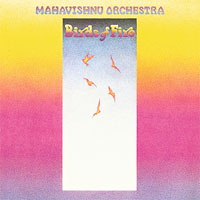Mahavishnu Orchestra • Birds of Fire
 lose to fifty years
after its initial release on Columbia Records comes a welcome reissue of Birds of Fire,
the original Mahavishnu Orchestra’s second release, which raised the bar on what was
then called (and since has become a much-maligned word) fusion. The 87 copies of
this classic album listed on Discogs attest to its popularity, and this version, featuring
all-analog production, should prove popular with fans and audiophiles alike. Guitarist
John McLaughlin uses the same group of exceptional musicians for Birds of Fire --
Jerry Goodman, violin; Billy Cobham, drums; Jan Hammer, keyboards (electric and acoustic
piano and synthesizer); and Rick Laird, bass -- he used on the group’s debut album, The
Inner Mounting Flame. lose to fifty years
after its initial release on Columbia Records comes a welcome reissue of Birds of Fire,
the original Mahavishnu Orchestra’s second release, which raised the bar on what was
then called (and since has become a much-maligned word) fusion. The 87 copies of
this classic album listed on Discogs attest to its popularity, and this version, featuring
all-analog production, should prove popular with fans and audiophiles alike. Guitarist
John McLaughlin uses the same group of exceptional musicians for Birds of Fire --
Jerry Goodman, violin; Billy Cobham, drums; Jan Hammer, keyboards (electric and acoustic
piano and synthesizer); and Rick Laird, bass -- he used on the group’s debut album, The
Inner Mounting Flame.
When the needle drops on the title tune, soon after three assertive gong strikes announce it, which soon explodes in a maelstrom of sound, uninitiated listeners might run for the exits. Stick with it, though, and you’ll be rewarded with some of the most passionate and tight ensemble playing on record. Slightly under forty minutes in length, the ten cuts (including the Miles Davis composition “Miles Beyond”) are a journey into odd time signatures (such as 9/4 and 7/8) and equally odd harmonies, all infused with a spirit of Eastern musical traditions. After the frenzy and menace of the title cut, things settle down on “Miles Beyond,” as Goodman and McLaughlin play the theme in unison after Hammer’s intro, followed by Goodman’s plucked-string improvisation. McLaughlin follows with a wild guitar solo that leads back into the opening theme, concluding the cut. The bass and drums are captured particularly well on this track. In fact, the recording of the bass and drum kit is exceptional throughout the LP. “Celestial Terrestrial Commuters” (where do these song titles come from?) is next, with a soft drum intro, statement of a convoluted theme and short keyboard solo. Then, fueled by Cobham’s propulsive drumming, McLaughlin and Goodman do an exhausting dueling-strings interlude, with more ensemble playing ending the cut. The next, “Sapphire Bullets of Pure Love” (here we go with those titles again), is 21 seconds of ambient found-sound and instrumental noise. What for and why? “Thousand Island Park” is perhaps the most traditional "song" on the album and showcases the chops of Goodman and McLaughlin as they skitter across their respective fret boards, pulling flurries of notes off the strings. Hammer plays acoustic piano (well recorded) on this one, with Laird’s bass beautifully present. The side’s closer, “Hope,” is a plodding, three-note phrase repeated insistently, seemingly acting as an introduction for a tune that never materializes. Side two opens with “One Word,” perhaps the most developed number on the album, where a drum roll leads to a riff signaling it’s off to the races, as Hammer, Goodman and McLaughlin, after a lengthy bass solo by Laird, steal the show with an extended “cutting session.” Each tries to outplay the other in a series of intense, furious solos of eight-bar, four-bar, two-bar and finally one-bar exchanges. Cobham eases the tension with a spirited drum solo, after which the three return, this time in unison, to end the tune. “Sanctuary,” the calmest number on the album, opens with McLaughlin and Goodman stating a somber theme, in unison, which evolves slowly until the end of the track. “Open Country Joy” opens with a countrified feel before the fury ascends from the silence in the form of McLaughlin’s frantic guitar along with Goodman’s and Hammer’s equally wild violin and keyboard. After a few minutes of free-for-all playing, the group returns to the country roots implicit at the outset. Finally, “Resolution’s” martial intro leads the ensemble into silence, after which the cut ends. As for the record itself, it maintains the high standard
set by Speakers Corner. A sticker on the shrink-wrap proudly proclaims “This LP is an
entirely analogue production” and it sounds it, sourced from original master tapes
and cut using Neumann cutting consoles. The sound reminds me of the pop albums I listened
to in the late 1960s and the 1970s, except it's much cleaner, with less compression and
greater dynamic range. The sturdy jacket presents an excellent re-creation of the original
artwork. Pallas pressed, the 180-gram vinyl LP is nestled in a nice inner sleeve and is
dead quiet, ruler flat and free of blemishes. Consistent with Speakers Corners’
adherence to accuracy, the record label is a fine facsimile of the red/gold Columbia label
used from the 1970s through the 1990s. As a final inducement, an eight-page catalogue of
current Speakers Corner releases is included. |
